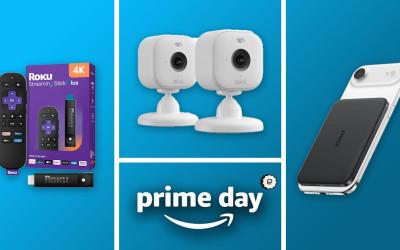In last month’s smart ring overview coverage, I mentioned two things that are particularly relevant to today’s post:
- I’d be following it up with a series of more in-depth write-ups, one per ring introduced in the overview, the first of which you’re reading here, and
- Given the pending ITC (International Trade Commission) block of further shipments of RingConn and Ultrahuman smart rings into the United States, save for warranty-replacements for existing owners, and a ruling announced a few days prior to my submission of the overview writeup to Aalyia, I planned to prioritize the RingConn and Ultrahuman posts in the hopes of getting them published prior to the October 21 deadline, in case US readers were interested in purchasing either of them ahead of time (note, too, that the ITC ruling doesn’t affect readers in other countries, of course).
Color compatibility
Since the Ultrahuman Ring AIR was the first one that came into my possession, I’ll dive into its minutiae first. To start, I’ll note, in revisiting the photo from last time of all three manufacturers’ rings on my left index finger, that the Ultrahuman ring’s “Raw Titanium” color scheme option (it’s the one in the middle, straddling the Oura Gen3 Horizon to its left and the RingConn Gen 2 to its right) most closely matches the patina of my wedding band:

Here’s the Ultrahuman Ring AIR standalone:

Skip the app
Next up is sizing, discussed upfront in last month’s write-up. Ultrahuman is the only one of the three that offers a sizing app as a (potential) alternative to obtaining a kit, although candidly, I don’t recommend it, at least from my experiences with it. Take a look at the screenshots I took when using it again yesterday in prepping for this piece (and yes, I intentionally picked a size-calibrating credit card from my wallet whose account number wasn’t printed on the front!):















 I’ll say upfront that the app was easy to figure out and use, including the ability to optionally disable “flash” supplemental illumination (which I took advantage of because with it “on”, the app labeled my speckled desktop as a “noisy background”).
I’ll say upfront that the app was easy to figure out and use, including the ability to optionally disable “flash” supplemental illumination (which I took advantage of because with it “on”, the app labeled my speckled desktop as a “noisy background”).
That said, first off, it’s iOS-only, so folks using Android smartphones will be SOL unless they alternatively have an Apple tablet available (as I did; these were taken using my iPad mini 6). Secondly, the app’s finger-analysis selection was seemingly random (ring and middle finger on my right hand, but only middle finger on my left hand…in neither case the index finger, which was my preference). Thirdly, app sizing estimates undershot by one or multiple sizes (depending on the finger) what the kit indicated was the correct size. And lastly, the app was inconsistent use-to-use; the first time I’d tried it in late May, here’s what I got for my left hand (I didn’t also try my right hand then because it’s my dominant one and I therefore wasn’t planning on wearing the smart ring on it anyway):

Sub-par charging
Next, let’s delve a bit more into the previously mentioned seeming firmware-related battery life issue I came across with my initial ring. Judging from the June 2024 date stamps of the documentation on Ultrahuman’s website, the Ring AIR started shipping mid-last year (following up on the thicker and heavier but functionally equivalent original Ultrahuman R1).
Nearly a year later, when mine came into my possession, new firmware updates were still being released at a surprisingly (at least to me) rapid clip. As I’d mentioned last month, one of them had notably degraded my ring’s battery life from the normal week-ish to a half day, as well as extending the recharge time from less than an hour to nearly a full day. And none of the subsequent firmware updates I installed led to normal-operation recovery, nor did my attempted full battery drain followed by an extended delay before recharge in the hope of resetting the battery management system (BMS). I should also note at this point that other Redditors have reported that firmware updates not only killed rings’ batteries but also permanently neutered their wireless connectivity.
What happened to the original ring? My suspicion is that it actually had something to do with an inherently compromised (coupled with algorithm-worsened) charging scheme that led to battery overcharge and subsequent damage. Ultrahuman bundles a USB-C-to-USB-C cable with the ring, which would imply (incorrectly, as it turns out) that the ring charging dock circuitry can handle (including down-throttling the output as needed) any peak-wattage USB-C charger that you might want to feed it with, including (but not limited to) USB-PD-capable ones.
In actuality, product documentation claims that you should connect the dock to a charger with only a maximum output of 5W/2A. After doing research on Amazon and elsewhere, I wasn’t able to find any USB-C chargers that were that feeble. So, to get there at all, I had to dig out of storage an ancient Apple 5W USB-A charger, which I then mated to a third-party USB-A-to-USB-C cable.




That all said, following in the footsteps of others on the Ultrahuman subreddit who’d had similar experiences (and positive results), I reached out to the Reddit forum moderators (who are Ultrahuman employees, including the founder and CEO!) and after going through a few more debugging steps they’d suggested (which I’d already tried, but whatevah), got shipped a new ring.
It’s been stable through multiple subsequent firmware updates, with the stored charge dropping only ~10-15% per day (translating to the expected week-ish of between-charges operating life). And the pace of new firmware releases has also now notably slowed, suggestive of either increasing code stability or a refocus on development of the planned new product that aspires to avoid Oura patent infringement…I’m hoping for the more optimistic former option!
Other observations
More comments, some of which echo general points made in last month’s write-up:
- Since this smart ring, like those from Oura, leverages wireless inductive charging, docks are ring-size-specific. If you go up or down a size or a few, you’ll need to re-purchase this accessory (one comes with each ring, so this is specifically a concern if, like me, you’ve already bought extras for travel, elsewhere in the house, etc.)

- There’s no battery case available that I’ve come across, not even a third-party option.
- That 10-15% per day battery drop metric I just mentioned is with the ring in its initial (sole) “Turbo” operating mode, not with the subsequently offered (and now default) “Chill” option. I did drop it down to “Chill” for a couple of days, which decreased the per-drop battery-level drop by a few percent, but nothing dramatic. That said, my comparative testing wasn’t extensive, so my results should be viewed as anecdotal, not scientific. Quoting again from last month’s writeup:
Chill Mode is designed to intelligently manage power while preserving the accuracy of your health data. It extends your Ring AIR battery life by up to 35% by tracking only what matters, when it matters. Chill Mode uses motion and context-based intelligence to track heart rate and temperature primarily during sleep and rest.
- It (like the other smart rings I also tested) misinterpreted keyboard presses and other finger-and-hand movements as steps, leading to over-measurement results, especially on my dominant right hand.
- While Bluetooth LE connectivity extends battery life compared to a “vanilla” Bluetooth alternative, it also notably reduces the ring-to-phone connection range. Practically speaking, this isn’t a huge deal, though, since the data is viewed on the phone. The act of picking the phone up (assuming your ring is also on your body) will also prompt a speedy close-proximity preparatory sync.
- Unlike Oura (and like RingConn), Ultrahuman provides membership-free full data capture and analysis capabilities. That said, the company sells optional Powerplug software add-ons to further expand app functionality, along with extended warranties that, depending on the duration, also include one free replacement ring in case your sizing changes due to, for example, ring-encouraged and fitness-induced weight loss.
- The app will also automatically sync with other health services, such as Fitbit and Android’s built-in Health Connect. That said, I wonder (but haven’t yet tested to confirm or deny) what happens if, for example, I wear both the ring and an inherently Fitbit-cognizant Google Pixel Watch (or, for that matter, my Garmin or Withings smartwatches).








- One other curious note: Ultrahuman claims that it’s been manufacturing rings not only in its headquarters country, India, but also in the United States since last November in partnership with a contractor, SVtronics. And in fact, if you look at Amazon’s product page for the Ring AIR, you’ll be able to select between “Made in India” and “Made in USA” product ordering options. Oura, conversely, has indicated that it believes the claimed images of US-located manufacturing facilities are “Photoshop edits” with no basis in reality. I don’t know, nor do I particularly care, what the truth is here. I bring it up only to exemplify the broader contentious nature of ongoing interactions between Oura and its upstart competitors (also including pointed exchanges with RingConn).
Speaking of RingConn, and nearing 1,600 words at this point, I’m going to wrap up my Ultrahuman coverage and switch gears for my other planned post for this month. Time (and ongoing litigation) will tell, I guess, as to whether I have more to say about Ultrahuman in the future, aside from the previously mentioned (and still planned) teardown of my original ring. Until then, reader thoughts are, as always, welcomed in the comments!
—Brian Dipert is the Editor-in-Chief of the Edge AI and Vision Alliance, and a Senior Analyst at BDTI and Editor-in-Chief of InsideDSP, the company’s online newsletter.
Related Content
- The Smart Ring: Passing fad, or the next big health-monitoring thing?
- Smart ring allows wearer to “air-write” messages with a fingertip
- The 2025 CES: Safety, Longevity and Interoperability Remain a Mess
- Can wearable devices help detect COVID-19 cases?
The post Can a smart ring make me an Ultrahuman being? appeared first on EDN.









